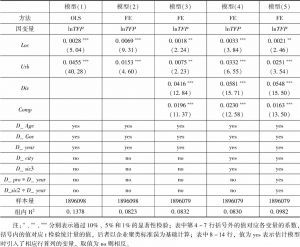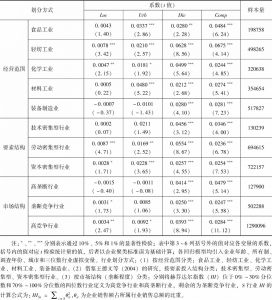摘要
集聚外部性与企业生产率是城市经济学研究的热点。作者采用1998年~2007年中国制造业企业的面板数据,检验不同类型集聚外部性对企业全要素生产率的影响。首先使用Olley和Pakes(1996)介绍的方法测算企业全要素生产率(Total Factor Productivity,TFP),然后利用固定效应回归估计集聚外部性模型。研究结果表明:(1)制造业企业TFP明显受益于马歇尔外部性、雅各布斯外部性和波特外部性,并且后两者发挥的作用更大;(2)轻纺工业和化学工业企业TFP明显受到马歇尔外部性的正影响,而食品工业、材料工业和装备制造业企业则反之;(3)与其他行业不同,技术密集型和高垄断行业企业TFP并未受到当地本行业和当地其他行业集聚外部性的影响。但是,不同类型行业企业均从城市产业多元化和同行企业竞争中获得了TFP增长。
作者
叶素云 (1986- ),女,中共北京市海淀区委党校讲师,邮政编码:100193。
YE Su-yun Party School of the Haidian Committee of Communist Party of China,Beijing 100872,China
- 薄文广(2007):《外部性与产业增长——来自中国省级面板数据的研究》,《中国工业经济》第1期,第37~44页。
- 柴志贤、黄祖辉(2008):《集聚经济与中国工业生产率的增长——基于DEA的实证分析》,《数量经济技术经济研究》第11期,第3~15页。
- 陈良文、杨开忠、沈体雁、王伟(2008):《经济集聚密度与劳动生产率差异——基于北京市微观数据的实证研究》,《经济学》(季刊)第1期,第100~114页。
- 范剑勇(2006):《产业集聚与地区间劳动生产率差异》,《经济研究》第11期,第72~81页。
- 范剑勇、冯猛、李方文(2014):《产业集聚与企业全要素生产率》,《世界经济》第5期,第51~70页。
- 范剑勇、石灵云(2009):《产业外部性、企业竞争环境与劳动生产率》,《管理世界》第8期,第65~72页。
- 傅十和、洪俊杰(2008):《企业规模、城市规模与集聚经济——对中国制造业企业普查数据的实证分析》,《经济研究》第11期,第112~125页。
- 鲁晓东、连玉君(2012):《中国工业企业全要素生产率估计:1999-2007》,《经济学》(季刊)第1期,第541~558页。
- 聂辉华、贾瑞雪(2011):《中国制造业企业生产率与资源误置》,《世界经济》第7期,第27~42页。
- 聂辉华、江艇、杨汝岱(2012):《中国工业企业数据库的使用现状和潜在问题》,《世界经济》第5期,第142~158页。
- 孙浦阳、韩帅、许启钦(2013):《产业集聚对劳动生产率的动态影响》,《世界经济》第3期,第33~52页。
- 王德文、王美艳、陈兰(2004):《中国工业的结构调整、效率与劳动配置》,《经济研究》第4期,第41~49页。
- 谢千里、罗斯基、张轶凡(2008):《中国工业生产率的增长与收敛》,《经济学》(季刊)第3期,第809~826页。
- 张海峰、姚先国(2010):《经济集聚、外部性与企业劳动生产率——来自浙江省的证据》,《管理世界》第12期,第45~52页。
- Boschma,R.,A. Minondo,and M. Navarro (2013),“The Emergence of New Industries at the Regional Level in Spain:A Proximity Approach Based on Product Relatedness”,Economic Geography,89,pp.29-51.
- Cainelli,G.,A. Fracasso,and G.V. Marzetti (2014),“Spatial Agglomeration and Productivity in Italy:A Panel Smooth Transition Regression Approach”,Papers in Regional Science,93(3),pp.1-29.
- Dekle,R. (2002),“Industrial Concentration and Regional Growth:Evidence from the Prefectures”,Review of Economics and Statistics,84,pp.310-315.
- Delgado,M.,C. Ketels,and M. E. Porter,et al.(2012),The Determinants of National Competitiveness,NBER Working Paper,No. 18249.
- Duranton,G. and D. Puga (2004),“Micro-Foundations of Urban Agglomeration Economies”,in Henderson V,Thisse J.F. (ed.),Handbook of Regional and Urban Economics IV,Amsterdam:North-Holland,pp.2063-2117.
- Glaeser,E. L. (2009),“The Wealth of Cities:Agglomeration Economies and Spatial Equilibrium in the United States”,Journal of Economic Literature,47(4),pp.983-1028.
- Glaeser,E. L.,H. D. Kallal,and J. A. Scheinkman,et al. (1992),“Growth in Cities”,Journal of Political Economy,100,pp.1126-1152.
- Henderson,J.V. (2003),“Marshall’s Scale Economies”,Journal of Urban Economics,53,pp.1-28.
- Jacobs,J. (1969),The Economy of Cities,New York:Vintage,pp.11-18.
- Ketels,C. (2013),“Recent Research on Competitiveness and Clusters:What are the Implications for Regional Policy?”,Cambridge Journal of Regions,6(2),pp.269-284.
- Lu Jiangyong and Zhigang Tao (2009),“Trends and Determinants of China’s Industrial Agglomeration”,Journal of Urban Economics,65,pp.167-180.
- Marschak,J. and W. Andrews (1944),“Random Simultaneous Equations and the Theory of Production”,Econometrica,12,pp.143-205.
- Marshall,A. (1890),Principles of Economics,Macmillan,London,pp.200-268.
- Martin,P.,T. Mayer,and F. Mayneris (2011),“Spatial Concentration and Plant-level Productivity in France”,Journal of urban economics,69(2),pp.182-195.
- Neffke,F.,M. Henning,and R. Boschma (2011),“How do Regions Diversify over Time?Industry Relatedness and the Development of New Growth Paths in Regions”,Economic Geography,87,pp.237-265.
- Olley,S. and A. Pakes (1996),“The Dynamics of Productivity in the Telecommunications Industry”,Econometrica,64(6),pp.1263-1298.
- Porter,M. (1998),“Clusters and the New Economics of Competition”,Harvard Business Review,12,pp.77-90.
- Rosenthal,S. and W. Strange (2004),“Evidence on the Nature and Sources of Agglomeration Economies”,In:Henderson V,Thisse J.F.(ed.),Handbook of Regional and Urban Economics IV,Amsterdam:North-Holland,pp.2119-2171.
- Yasar,M. and R. Raciborski (2008),“Production Function Estimation in Stata Using the Olley and Pakes Method”,The Stata Journal,8(2),pp.221-231.





